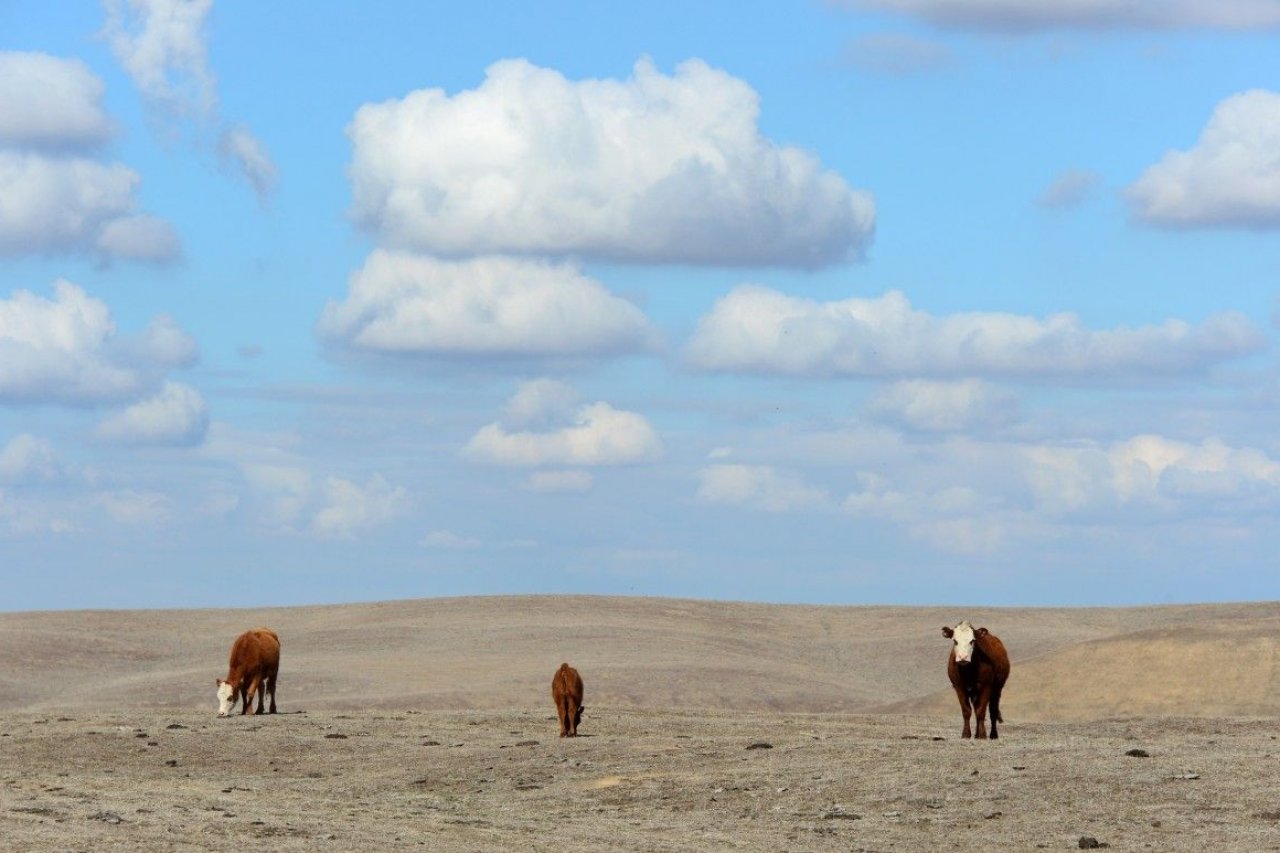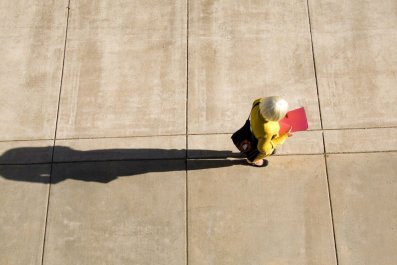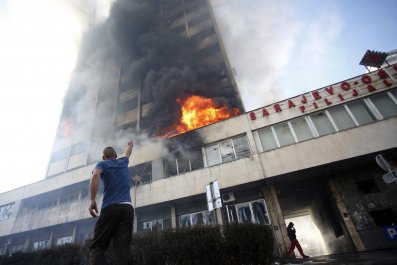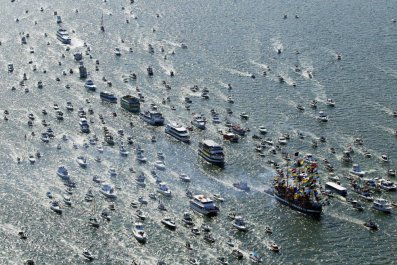Coming soon to a grocery store near you: higher food prices, because California, which grows more half of the nation's fresh fruits and vegetables, is in its third consecutive year of getting only about one-eighth the usual amount of water from snow melting in the High Sierras.
California is called the Golden State not because of the gold found at Sutter's Mill in 1848, but because winter rains make the hills green until the dry air of summer turns them a golden hue. This winter, many of those hills remain brown and gray as even weeds died from lack of moisture.
The worst drought the state has endured in more than 500 years is forcing farmers to let fields lie fallow, send half-grown steers to the slaughterhouse and trim back vines and trees in the hope they can get just enough water to keep their expensive plants alive. Cutting production because of water shortages this year will translate into higher prices for almonds, beef, cauliflower, table grapes, oranges, walnuts and even wines. California supplies America with more than 90 percent of its almonds, broccoli, celery, kiwis, lemons, nectarines, pistachios and plums, and is also the leading state in the very water-intensive dairy business.
These shortages may continue for several years unless the heavens open up in the next few weeks, dropping snow in the Sierra Nevadas and steady rains along the coast and in the Central Valley. And if the current drought is part of a long-term shift in weather patterns, the effect on what Americans eat and how much they pay for it could be dramatic not just in the California, but in Chicago and Cincinnati and Charlotte.
The trend toward less water began in 1975, according to records kept by the South San Joaquin Irrigation District, which serves the area around Manteca, a farming center 80 miles east of San Francisco. Town fathers there had the foresight in the 1860s to build an irrigation system that grew to include three dams to store water and generate electricity. "Our records show that in the 80 years from 1895 to 1975 we had just seven years when there was not enough snow for us to get our full allotment of Stanislaus River water," Jeff Shields, the district general manager says, "but since 1975, this has happened 14 times."
Water in various parts of the Sierra Nevada snowpack is currently between 11 percent and 40 percent of the long-term average, according to Los Angeles Water and Power and state Department of Water Resources officials. Some major reservoirs are at less than half of capacity. Willits, 135 miles north of San Francisco, had just a 100-day supply of water last month, but recent rains have raised that to 133 days.
Snow with too little water in it means dry forests, which increases the likelihood of more fires in summer and fall. The Rim Fire last year blackened more than 400 square miles of the Sierras and took two months to extinguish. The massive amount of water taken from reservoirs to fight that fire is another reason they are so low today.
Extended droughts are new to modern California. The worst previous dry spell, in 1977 and 1978, forced water rationing in affluent Marin County across the Golden Gate Bridge from San Francisco. As water wells spit air and reservoirs turned to beds of dried clay, lawns died and pedestrians yelled at people in freshly washed cars. In Marin, toilet flushing had to be restricted - every schoolchild knew the drought slogan: "If it's brown flush it down, if it's yellow let it mellow."
In geologic terms, though, extended droughts are nothing new. Analysis of tree rings found that California twice endured droughts that lasted about two centuries each, both during the Middle Ages.
For more than four decades official reports have cautioned that California could suffer long droughts and that population growth was outstripping storage capacity. Yet despite repeated warnings, many California farming communities are ill-prepared for a parched future that seems to have arrived.
California Governor Jerry Brown declared a state of emergency January 17, but neither Sacramento nor Washington has done much more about the drought than document it. The state and U.S. Agriculture Secretary Tom Vilsack announced February 5 that $34 million would be made available for future projects to conserve water to "demonstrate a united and coordinated" drought response. On Wednesday officials announced another $153 million in grants from a $1 billion bond offering voters approved in 2006, much of which has yet to be spent.
How did Central Valley officials fail to prepare? As recently as 1960 Los Angeles County ranked first in America in the value of crops it produced, but the rising cost of water, and suburban sprawl, wiped out most of those farms.
Today in the city of Los Angeles, which imports more than two thirds of its water from Northern California and the Colorado River, homeowners can collect $2 for each square foot of green grass that they replace with xeriscaping, from a Greek word meaning plants that do not require irrigation. Los Angeles uses less water - about 129 gallons per person each day - than almost any other big American city. That's down from 172 gallons in 1980. The city's 3.9 million people use less water today than L.A. did 40 years ago, when it had 1 million fewer residents.
The state now has more than 38 million residents, but the water saved by xeriscaping, low-flow shower heads and toilets that use half as many gallons per flush (but often require multiple flushes) is just a puddle compared to the lakes of water consumed by farms.
Instead of using drip lines, injection into the soil and other systems to reduce water consumption, many California farms are irrigated via canal and ditch systems that would be recognizable to farmers in Sumer (now Iraq) 7,000 years ago. Flooding fields is still common partly because federal subsidies make water cheap when there is abundant snow.
In California, and much of the Great Plains, the water table - how far under the surface the soil is always wet - has been falling for decades as humans pump water out much faster than nature replenishes its underground aquifers. Depleting groundwater by pumping is also a reason sinkholes have been in the news, and why you might have read about the Florida man who was swallowed by one last March along with his house.
However, one small farming community is way ahead in planning and technology, adopting techniques that can grow 30 percent more food with 30 percent less water. The South San Joaquin Irrigation District around Manteca may escape the worst of this drought because of those dams it built long ago and its embrace of new water-saving technology.
Thanks to those dams, and profits from selling electricity, the district sells water to its farmers for about $6 an acre-foot, while other California farmers are paying as much as $1,300 per acre foot. (An acre-foot means an acre of land with one foot of water over it, about 325,851 gallons.)
Having been ahead of the water game for more than a century, the district moved two years ago to stay ahead by investing in a new system that replaces flooding with concentrated watering around trees, vines and row crops. The water automatically shuts off when the ground reaches a predetermined level of moisture, and farmers only need give one day's notice to order water from their cellphones.
The cost of the new pressurized and remote-controlled system may raise the price of this water by half, to $9 an acre-foot, Shields says. That's still a bargain compared to what other California farmers pay.
One of the district's biggest farmers, Bob Brocchini of Ripon, whose family tends 3,000 acres of olives, cherries, grapes and walnuts says, "We used to do field flooding, but this is much better, much easier. We can saturate the ground and then water again before the plants are stressed. And because the quality of the water from the Stanislaus is better than pumped groundwater, which can be salty, the quality of the crop should be better."
Only a few thousand of the district's more than 50,000 acres of irrigated land have been put on the new system and completing the changeover may take a decade. Brocchini and Manteca area farmers Steve Van Duyn and John Van Till say the new system will also mean fewer farmers running diesel generators for the electricity needed to pump water, which in turn will reduce the air pollution the Central Valley has become known for.
Shields is surprised more irrigation districts have not already moved away from flooding irrigation. If the drought conditions endure, he says, the Central Valley will have no choice but to install efficient modern water systems to limit the damage from mother nature blowing dry air over California.
As long as farmers in California resist the switch to more efficient technology, count on erratic supplies and higher prices for the beef, cheeses, fruits, nuts and vegetables.






















